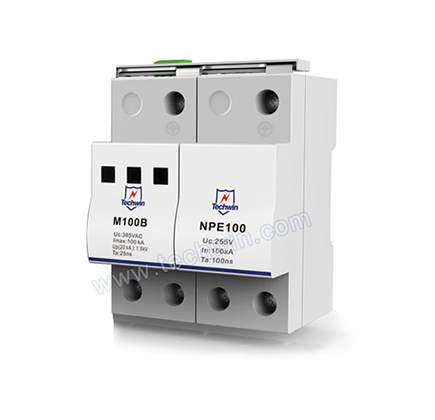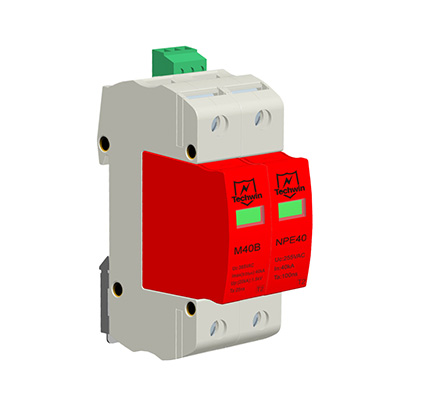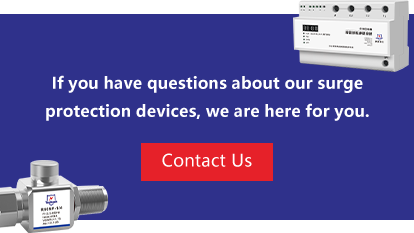Power supply surge protection for industrial control panels is not just a recommended practice but an essential legal requirement, a mandatory measure to protect electrical systems. Typical control panels are usually equipped with backup fuses larger than 315A, and the distribution board's surge protector works alongside the backup fuses. These backup fuses have high demands on cable length and protection levels, making the installation of surge protectors particularly important.
Control panels can be seen as central power hubs connecting various electrical devices, making them susceptible to events such as lightning strikes and surges that can lead to equipment damage, surge interruptions, and downtime losses. Here are the main benefits of power supply surge protection for industrial control panels:
Surge protection effectively prevents overvoltage from entering the electrical infrastructure through the control panel, extending the lifespan of the equipment and avoiding costly damage and interruptions.
Surge protection helps prevent faults caused by power surges, ensuring continuous operation of industrial and commercial facilities. This is especially crucial for critical production and operational environments.
Surge protection reduces the risk of fires and personal injuries that surges might cause, ensuring workplace safety is a top priority.
In the long term, surge protection significantly reduces costs by lowering equipment replacement costs, reducing downtime losses, and cutting maintenance expenses.
Given these significant advantages, it is crucial to install surge protection devices in the control panel's distribution board. Surge protectors in the main distribution box can discharge most of the overcurrent, but relying solely on the main distribution box's protection may not fully protect the entire system, as residual energy could still reach sensitive electronic equipment. Therefore, terminal surge protectors must always be installed close to the equipment.

Installing a Type 1 SPD at the entry point of the electrical system as the first line of defense against voltage spikes and surges entering the electrical system is crucial. This primary protection measure effectively prevents surges from further spreading into the building's wiring system and eventually reaching sensitive electronic equipment.
The closer the distance between the surge protector and the main power source, the more effective the protection. Installing surge protectors at the entry point can significantly reduce the risk of voltage spikes affecting sensitive equipment.
However, it is impossible to discharge 100% of overvoltage at once, requiring the installation of Type 2 SPD close to the equipment for precise protection of sensitive equipment.

The faster the response of the surge protector to transient events, the better it can transfer excess energy away from the equipment. Installing surge protectors close to the equipment can shorten the distance a surge must travel before encountering the protection device.
Tailor-made Type 2 SPDs for specific circuits or devices are usually installed near the equipment for more precise protection of each circuit or device. These protective devices must be installed in series with the main surge protector to ensure effective protection at all levels during a surge event.
If a surge protector exceeds its capacity limit, it may be damaged due to a short circuit. Additional protective devices must be installed in series upstream of Type 2 SPD.
A short circuit occurs when a low-resistance connection is accidentally established between two conductors in the electrical system.Type 2 SPD must have a short-circuit current rating (ISCCR) at least equal to the short-circuit current at the connection point.
When the main distribution box uses a TN-C system, a maximum distance of 3m is required, and another 0+0.5 configuration lightning protector is needed.
 Introduction to Signal Surge Protector and Its Lightning Protection FunctionMarch 4, 2022A signal surge protector is a type of surge protection devices that is linked in series on a signal line to reduce transient over-voltages and deflect surge currents away from the signal line. Signal ...view
Introduction to Signal Surge Protector and Its Lightning Protection FunctionMarch 4, 2022A signal surge protector is a type of surge protection devices that is linked in series on a signal line to reduce transient over-voltages and deflect surge currents away from the signal line. Signal ...view Surge Protector SPD Selection CriteriaMay 20, 2022The surge protector is divided into three levels according to the area that needs to be protected. The first level surge protector can be applied to the main power distribution cabinet in the building...view
Surge Protector SPD Selection CriteriaMay 20, 2022The surge protector is divided into three levels according to the area that needs to be protected. The first level surge protector can be applied to the main power distribution cabinet in the building...view How Power Surge Circuit Breakers Enhance Home Safety and Appliance LongevityJune 6, 2024In an age where technology and electrical appliances dominate our daily lives, safeguarding our homes from electrical hazards has never been more crucial. One significant advancement in this domain is...view
How Power Surge Circuit Breakers Enhance Home Safety and Appliance LongevityJune 6, 2024In an age where technology and electrical appliances dominate our daily lives, safeguarding our homes from electrical hazards has never been more crucial. One significant advancement in this domain is...view How to Wire a Three-phase Surge Protector?September 22, 20221. Wiring method of three-phase surge protectorIn the TN system, in general, the surge protector only needs to be connected in common mode, that is, connected between the neutral line of the phase lin...view
How to Wire a Three-phase Surge Protector?September 22, 20221. Wiring method of three-phase surge protectorIn the TN system, in general, the surge protector only needs to be connected in common mode, that is, connected between the neutral line of the phase lin...view What Is a Surge Circuit Breaker?June 26, 2024Surge Circuit Breaker, also known as SCB, is a new type of product used to replace traditional dedicated circuit breakers or fuses. It is specially designed for surge current protection, addressing th...view
What Is a Surge Circuit Breaker?June 26, 2024Surge Circuit Breaker, also known as SCB, is a new type of product used to replace traditional dedicated circuit breakers or fuses. It is specially designed for surge current protection, addressing th...view Technical terminology in IEC61643 standards-1December 8, 20212.1 Technical Term2.1.1. Lightning electromagnetic impulse (LEMP)It is a source of interference. Refers to the effect caused by lightning directly hitting the lightning protection device of a building...view
Technical terminology in IEC61643 standards-1December 8, 20212.1 Technical Term2.1.1. Lightning electromagnetic impulse (LEMP)It is a source of interference. Refers to the effect caused by lightning directly hitting the lightning protection device of a building...view